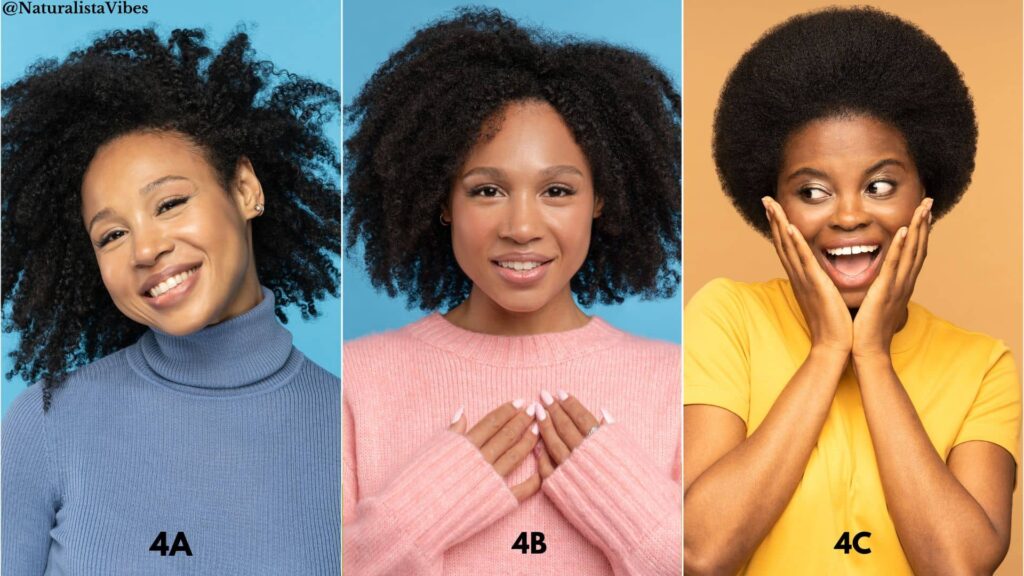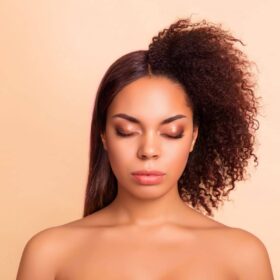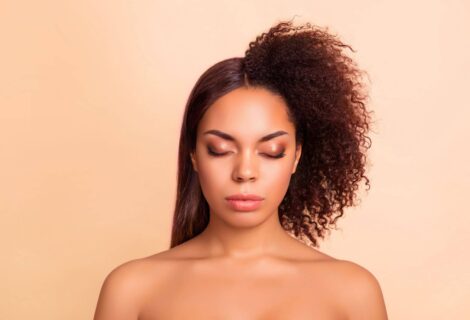This post may contain affiliate links and we may get paid a small commission if you click on a link. Please read our privacy policy and cookies disclosure.
Do you struggle to understand your hair type and texture? Sometimes it’s hard to know if you’re a 4A, 4B or 4C natural. Especially if you don’t have an understanding of the different coil textures and patterns. Many Type 4 Naturalistas assume they have 4C hair but instead have 4A or 4B hair. Tbh – It’s easy to be confused as many people refer to the hair type as afro coily or afro kinky. So why is it important to know your hair type? It helps you to care for your hair properly and supports you with identifying what products to incorporate into your hair regimen. It’s definitely possible to have multiple hair textures – for instance – a mix of 4A & 4B OR a mix of 4B & 4C but it’s likely one type will be more prominent over the other.
If you don’t know the difference between 4A, 4B or 4C hair OR then read this article to get more insight. You’ll learn how to differentiate the Type 4 hair textures and tips on how to properly care for your hair. We also spend time running through common questions Type 4 Naturalista’s ask. Keep reading to learn more!
What is Type 4 Hair
Type 4 hair is typically referred to as afro, coily or kinky hair. It’s the most unique of all the hair types because of its the coil pattern and shape. What makes Type 4 hair unique is the versatility it offers. It has the ability to be straight, curl/coil and shrink. The texture offers a variety of styling options in comparison to Type 2 and 3 hair. It’s the most fragile of all the hair types and has fine strands which makes caring for it slightly difficult if you’re not using the right techniques, tools and products.
Here are some characteristics of Type 4 hair;
- S or Z shaped coil pattern
- Shrinks up to 70% of its length
- Prone to breakage
- Tends to be dry and be frizzy
- Hair strands densely packed together
- Tangles easily
How do I know if I have 4A, 4B or 4C Hair?

Let’s delve into 3 textures that form this hair type in more detail…
4A HAIR
4A hair has a distinct “S” shaped coil pattern. The coils are springy and similar to the size of a crochet needle. The coils are densely packed together but the coil pattern is very visible. It shrinks up to 60% of the hairs length and is the loosest of all the Type 4 hair types. 4A hair has great moisture retention levels but is still prone to dryness and breakage.

4B HAIR
4B hair is easily confused with 4C hair due to both being “Z” shaped. The coil pattern is tight but not as tight as 4C hair. You can usually see the Z shape when your hair is wet. This hair type is prone to a lot of shrinkage, usually up to 70% of the length. Keeping the hair hydrated is key with this hair type. It takes a little longer for moisture to travel through the hair strands due the coil shape.

4C HAIR
4C hair has an extremely tight “Z” coil pattern. It’s not as loose as 4B even though the shape is very similar. 4C hair is the most fragile of all the Type 4 hair types so detangling with TLC is key to minimise any breakage. Work in sections and use tools like a wide tooth comb to minimise any tugging and pulling of the hair. Similar to 4B hair, 4C hair also experiences a significant amount of shrinkage (up to 80% for some naturals). Hydration is also key for this type, it’s important to use a moisture retention technique to lock it in.

How often should 4A, 4B or 4C hair be washed?
The rule of thumb is to wash your hair every 2 weeks. But depending on your lifestyle, this could be more often or less. We wouldn’t recommend going past the 4 week mark even if you’re wearing protective style. A healthy and clean scalp is important for your hair to thrive.
As Type 4 hair is prone to dryness and breakage, it’s important not to strip the hair of its natural oils when shampooing. Stick to hydrating and moisturising shampoos which minimise the loss of oils and always follow up with a conditioner to replenish your hair with moisture. Always use a with a leave-in conditioner once done to lock in additional moisture and keep your hair hydrated until your next wash day.
It’s also important to use a clarifying shampoo every 4 to 6 weeks to minimise any build up from hair products and daily styling. If you’re not a fan of clarifying shampoos then try a bentonite clay mask.
How can I make my Type 4 hair more manageable?
People have typically opted for relaxers in the past for ease of styling. For some reason, people think type 4 hair isn’t manageable but we’re here to dispel that myth. Whether you’re newly natural, a lazy natural or experienced natural – your hair is manageable. All you need is the right tools and techniques to care for your hair. As part of the process, you’ll need to create a natural hair routine and ensure you’re using products your hair has a liking to.
Here are some key elements to incorporate into your routine to make your type 4 hair easier to work with.
Moisture, Moisture, Moisture
Type 4 hair needs more moisture compared to other hair types. The “S & Z” shape makes it harder for moisture to travel down the hair shaft. Which is why the texture is prone to breakage and dryness. Utilise a moisture retention technique like the LOC or LCO method to keep your hair hydrated for longer. Spritzing your hair with water and leave-in mixture is one way to get moisture into your hair strands in between wash days.
Detangle your hair thoroughly
Type 4 hair has a fine texture and is densely packed together so it’s important to detangle your hair thoroughly to reduce any breakage. Always detangle on damp hair and never dry hair. Use a detangling tool like a wide tooth comb or detangling brush and take your time. Using a product with some slip like a conditioner or detangling lotion will make the process easier. The product helps you glide through your hair smoothly without pulling and tugging on your hair strands..
Some naturals forget to detangle prior to shampooing and do it when they’ve applied conditioner. But you must detangle prior to washing your hair to minimise excess shedding.
Work in sections
Work in sections of 4 to 6 depending on the length of your hair. This will make detangling, styling and washing your hair a smoother process.
Wear styles that don’t need to be re-done daily
Daily styling and over manipulation leads to breakage and loss of hair. Stick to protective styles that keep your hands out of your hair for at least 1 week. Type 4 hair is versatile enough for you to have several styling options. Experiment with buns, twists, braids, cornrow, afro puffs etc. Whatever style you choose, make sure you don’t do the same style back to back to give your hair a break and reduce any tension on your hairline.
Stay on top of trims
Trim your hair every 12 weeks to minimise split ends and single strand knots travelling up the hair shaft. Keeping on top of your trims makes detangling easier, keeps your coils defined and improves the overall health of your hair.

Frequently Asked Questions
1: How do you treat type 4 hair?
Use deep conditioning treatments to replenish your hair. It doesn’t have to be every wash day but aim for at least once a month. Deep conditioners are good for adding moisture back into the hair whilst minimising frizz and dryness. It also helps repair damage and nourish your hair back to health. Read our Deep Conditioning guide for Type 4 Naturals for some product recommendations.
Clay Washes are another treatment that is quite underrated but offers great benefits. It’s not something you should do regularly but a nice treat for your hair especially for low porosity naturals. It draws out impurities from your scalp and deeply clarifies your hair follicles making it easier for water and moisture to be absorbed. They also have healing and regenerative properties, getting rid of dryness and flakiness whilst adding shine back into your hair.
2: How do you hydrate type 4 hair?
The best way to keep your hair hydrated is utilising the LOC or LCO method to moisturise your hair. It keeps moisture locked into your strands for at least a week by sealing with an oil or butter. Read our article on LOC vs LCO method! Which one should you choose?
Wear a silk or satin scarf at night and sleep on a silk pillowcase for that extra protection. Cotton is known for absorbing oils and moisture from hair and skin leading to dryness.
Staying hydrated from the inside is another way to get extra hydration into your hair strands. Aim to drink up to 2 litres per day.
3: How do I stop my type 4 hair from shedding?
Shedding is a normal part of your hair’s life cycle. Women typically shed 50 – 100 days per day so it shouldn’t be something you’re alarmed about. However, excessive shedding is a problem! You’ll know if you have excess shedding from the amount that falls out on wash days or when styling your hair.
Excessive shedding is caused by a variety of factors such as stress, diet, hair care practices etc. As shedding is part of your hair growth cycle – you’ll need to replenish your strands starting from the inside as opposed to just your hair regimen. Here are some things worth incorporating into your regimen.
- Eat a well balanced diet with lots of protein. Protein strengthens hair strands and will be a good source for replenishing your follicles.
- Take hair supplements and vitamins known for boosting your hair health.
- Incorporate scalp massages into your routine. Scalp massages boost the flow of blood into your follicles and help thicken your strands.
- Increase your water intake – water helps keeps you hydrated and will act as a source of moisture for your strands.
Another thing that could be contributing to shedding is if you’re lacking iron or have a vitamin D deficiency. It’s worth doing a blood test to know exactly what your ferritin and Vitamin D levels are and discuss the results with your doctor to get advice on what supplements to take. Black people tend to have low levels of Vitamin D in western countries due to the lack of sun.
“A vitamin D deficiency affects your hair life cycle and is associated with scarring alopecia”. 1
4: Why is my type 4 hair breaking?
Type 4 hair is prone to breakage due to the nature and shape of the hair strands. They’re tightly coiled and moisture tends to have a difficult time travelling through the length of the strands. As a result, your hair can become brittle and extremely dry leading to breakage. It’s important to incorporate good hair practices to minimise breakage and keep your hair hydrated at all times.
Here are some things you might be doing that could lead to breakage;
- Over manipulating your hair with daily styling
- Excessive use of heat
- Bleaching hair excessively
- Protective styles that pull on your and are too tight
- Not washing your hair and keeping up with your moisture routine whilst wearing protective styles
Be mindful of these things and adjust your hair regimen accordingly. You’ll notice the word excessive is used when it comes to heat and bleaching. There are many naturals who use heat and dye their hair but have healthy hair. So it’s not a case you can’t do these things but moderation is key!
Final Thoughts
You should now have a thorough understanding of Type 4 hair and be able to identify if you have 4A, 4B or 4C texture. The key to maintaining Type 4 hair lies in your hair regimen and we hope you’ve been able to come away with some tips on how to maintain it.
If you’re new on your journey or struggling to embrace your hair then read our article on 5 ways to embrace your natural hair journey.
Are you a 4A, 4B or 4C Natural? And What’s your no 1 tip for maintaining your Type 4 hair?
Leave a comment below, we’d love to hear from you.
References :
- Saini K, Mysore V. Role of vitamin D in hair loss: A short review. J Cosmet Dermatol. 2021 Nov;20(11):3407-3414. doi: 10.1111/jocd.14421. Epub 2021 Sep 22. PMID: 34553483. ↩︎










